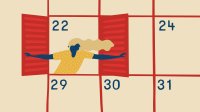Strategies for Working Efficiently When Teaching Online
Teaching in distance and hybrid models is time-consuming, so teachers need to make sure they use their time well.
Your content has been saved!
Go to My Saved Content.Teaching in a hybrid in-person/remote model requires significantly more planning than teaching in the traditional classroom model. Tasks that were once quick, such as monitoring students’ progress during class and following up on late and missing assignments, have become laborious, and everyday activities like making sure that students have access to material from the school library and determining the best technology tools to meet students’ needs take a tremendous amount of planning. More than ever, it’s important that I use my time efficiently and allow myself time to recharge.
Organizing Tasks
Given the variety of tasks that I need to complete, I create a detailed, handwritten list every Friday that guides me through the coming week. I divide it into four parts (Long-Term Goals, Do Now, Creating, and Doing), which helps me to stay organized and use my time more effectively.
The Long-Term Goals section is for anything that does not have to be immediately done and often includes things that I hope to accomplish but are optional. I write these out on the side of my list in the upper right corner, and whenever I have extra time, I work on them. The Do Now section is a running log of all the things I need to do in the next 24 hours, and I mark them off as I go. The Creating section is for anything that requires focus and critical thinking. This space is often filled with tasks such as designing assessments, creating new units, or writing a complex email. The Doing section is for tasks that do not require much mental effort. This space is often filled with items such as making copies, grading, or entering grades in the grade book.
By organizing tasks into sections, I can clearly see if I have a lot of the same type of tasks and then tackle them at the same time. Once I get into a rhythm, I move much faster through tasks.
I do the most complex tasks when I’m at my best. For me that’s first thing in the morning, and I try to get to work 30 minutes early so that I have time to knock out as many of the Creating tasks or long-term goals as possible. I’m amazed by how I can sometimes do more in 30 minutes before school than in an hour in the middle of the day.
I rewrite my list on Friday afternoons on a new sheet of paper—it’s satisfying to see how much I do not have to carry over to the next week, and the list reminds me of things I need to make time for.
Plan for Breaks
When I plan breaks, I’m more productive and avoid getting distracted and taking them unintentionally. This also allows me to use my time to be productive and to reset. If I need to think critically about a new idea or complex problem, I take a walk around the school. Going for a walk means I’m not distracted and feel refreshed and ready to tackle the task when I return to my desk.
I know how easy it can be to start talking to a friend at work and then realize that I’ve spent my entire free period chatting. Sometimes that’s just what I need, but if I know that I have a lot of things to do, I make a point of waiting to start the conversation when there are only 10 minutes left in the period so that I will get a break, but with a hard stop.
Say No and Trust
Saying no when asked to do something has always been difficult for me. I worry about letting people down, I feel responsible for things that logically I know are not my obligation, I want to do whatever I can to help, and I have a hard time waiting on others to get things done. However, I have realized that there are times when it is better to say no. When deciding if I will say yes or no, I consider if it is something that I have the ability and time to do well and if taking it on will compromise my other commitments.
I also am not great at dividing tasks and prefer to do everything myself, but I have come to see the value in trusting colleagues to divide and conquer. If a colleague volunteers to do something, I let them, instead of insisting that I can do it myself.
Grading Strategically
By making intentional decisions about what assignments I grade, creating rubrics, and using online tools, I can give detailed feedback on graded assignments without spending every evening grading papers.
When deciding what to formally grade, I consider the purpose of the assignment. I ask my students to write almost every day, but if my intention is for them to process their learning or organize their ideas, grading isn’t critical. If students are sharing out their ideas in a presentation, I assign grades while they are presenting. If students are completing multiple variations on the same type of assignment, such as reflections about a novel, I will select just a few to grade.
When assigning lengthy projects or papers, I take the time up front to create a detailed rubric, knowing that I will save a significant amount of time during grading.
When I need to quickly check understanding, I use digital tools like Socrative, Quizlet, Kahoot, and Google Forms that can automatically grade assignments and provide students with instant feedback. I can type much faster than I can handwrite, so I have students turn in many of their writing assignments on Google Classroom, which allows me to type comments.
